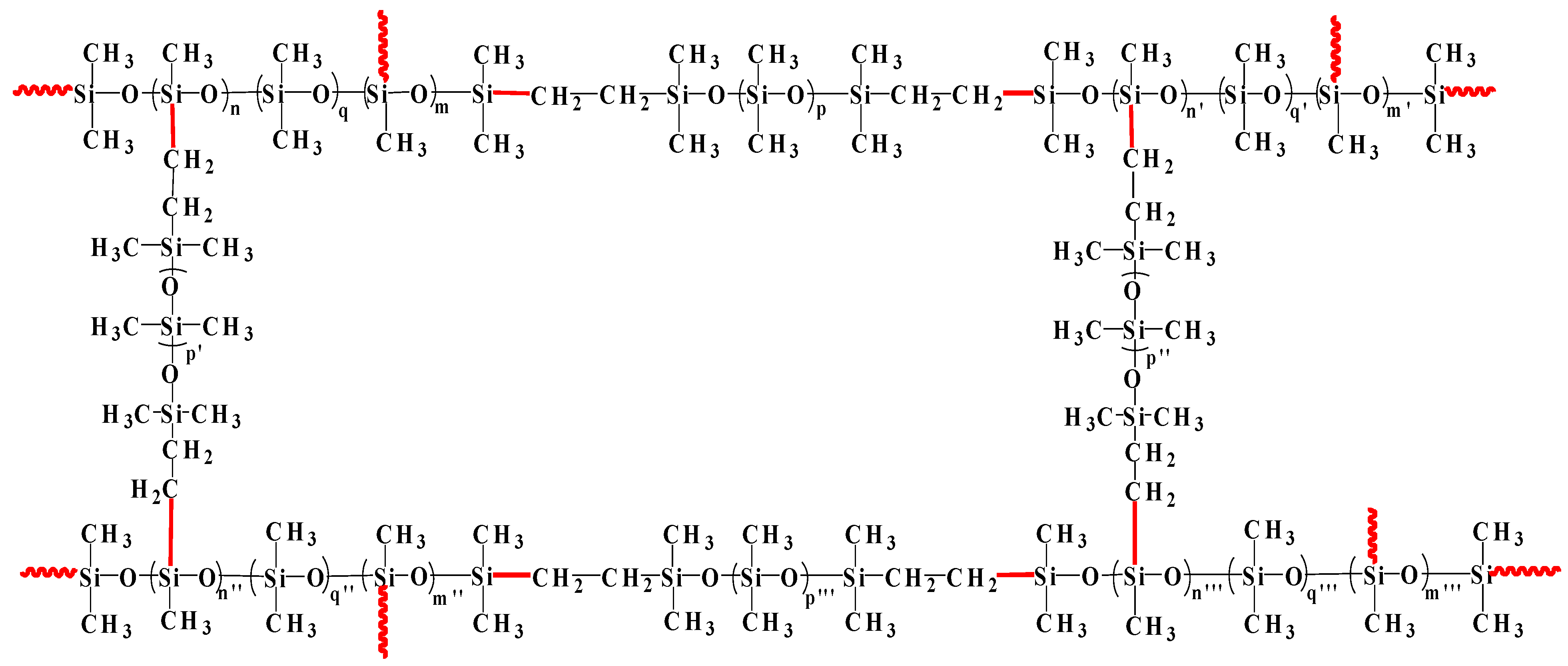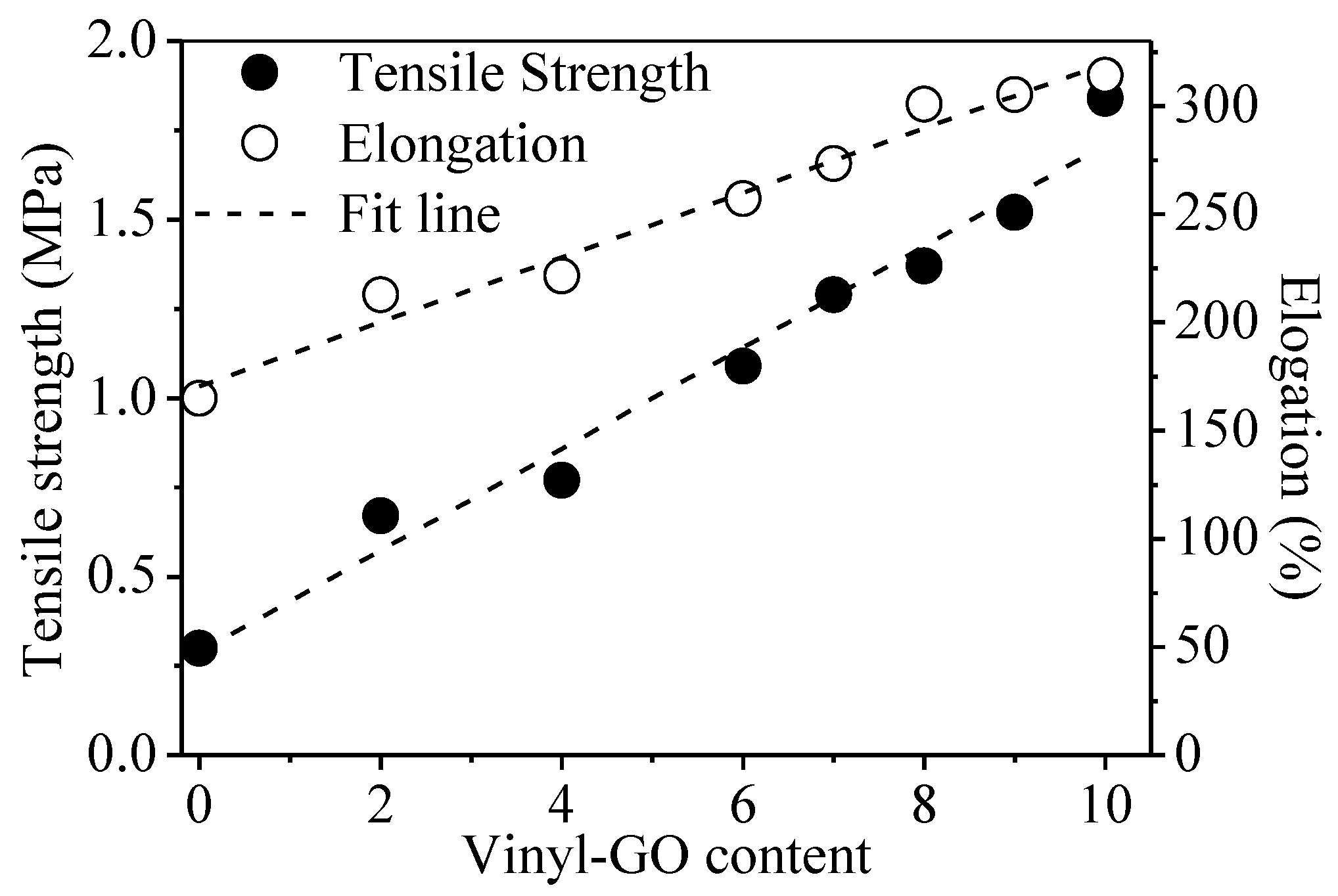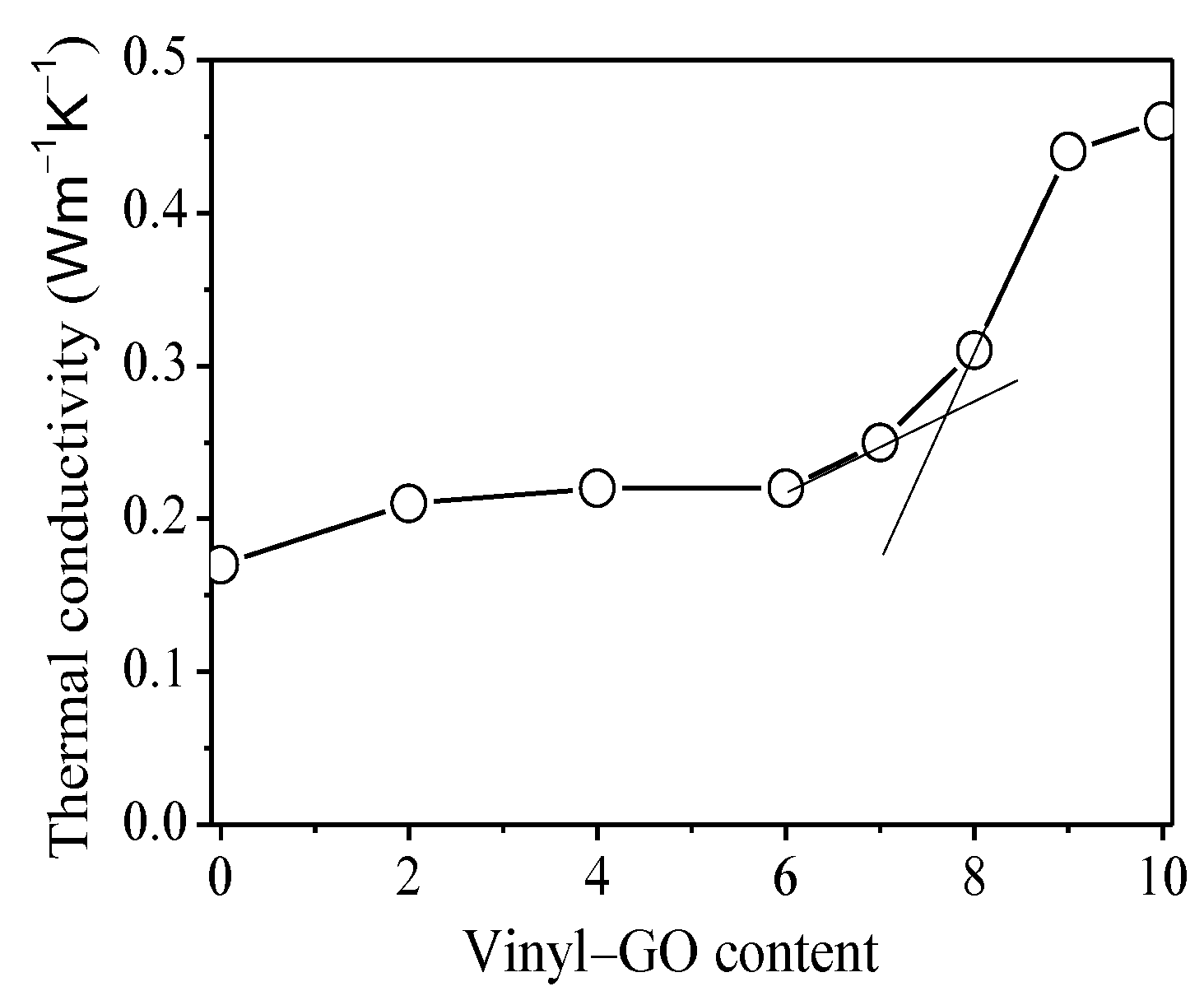Thermally Conductive and Antistatic Properties of Silicone Rubber Reinforced by the Modified Graphene Oxide
Abstract
1. Introduction
2. Materials and Methods
2.1. Materials
2.2. Preparation of the Modified GO
2.3. Preparation of Organosilicon Compound
2.4. Curing of Organosilicon Compound
2.5. Curing of SR/Vinyl-GO Nanocomposites
2.6. Characterization
3. Results
3.1. Characterization of Vinyl-GO and GO
3.2. Tensile Properties of SR/Vinyl-GO Nanocomposites
3.3. Thermal Stability of SR/Vinyl-GO Nanocomposites
3.4. Thermal Conductivity of SR/GO Nanocomposites
3.5. Antistatic Property of SR/Vinyl-GO Nanocomposites
3.6. Morphological Characterization of SR/GO Nanocomposites
4. Conclusions
Author Contributions
Funding
Institutional Review Board Statement
Informed Consent Statement
Data Availability Statement
Conflicts of Interest
References
- Wan, J.; Li, C.; Fan, H.; Li, B. Branched 1,6-diaminohexane-derived aliphatic polyamine as curing agent for epoxy: Isothermal cure, network structure, and mechanical properties. Ind. Eng. Chem. Res. 2017, 56, 4938–4948. [Google Scholar] [CrossRef]
- Fayaz, I.; Peerzada, G.M.; Ganaie, N.B. Comparative study of different methods of synthesis and their effect on the thermomechanical properties of a halogenated epoxy-based flame-retardant resin. ACS Omega 2022, 7, 1035–1047. [Google Scholar] [CrossRef] [PubMed]
- Kumar, V.; Azam, S.; Alam, M.N.; Hong, W.B.; Park, S.S. Novel rubber composites based on copper particles, multi-wall carbon nanotubes and their hybrid for stretchable devices. Polymers 2022, 14, 3744. [Google Scholar] [CrossRef] [PubMed]
- Li, X.; Zhou, Y.; Bao, Y.; Wei, W.; Fei, X.; Li, X.; Liu, X. Bismaleimide/phenolic/epoxy ternary resin system for molding compounds in high-temperature electronic packaging applications. Ind. Eng. Chem. Res. 2022, 61, 4191–4201. [Google Scholar] [CrossRef]
- Liang, X.; Dai, F. Epoxy nanocomposites with reduced graphene oxide-constructed three-dimensional networks of single wall carbon nanotube for enhanced thermal management capability with low filler loading. ACS Appl. Mater. Interface 2020, 12, 3051–3058. [Google Scholar] [CrossRef]
- Zhang, L.; Zhang, X.; Hua, W.; Xie, W.; Zhang, W.; Gao, L. Epoxy resin-hydrated halt shaped composite thermal control packaging material for thermal management of electronic components. J. Clean. Prod. 2022, 363, 132369. [Google Scholar] [CrossRef]
- Gao, N.; Liu, W.; Yan, Z.; Wang, Z. Synthesis and properties of transparent cycloaliphatic epoxy-silicone resins for opto-electronic devices packaging. Opt. Mater. 2013, 35, 567–575. [Google Scholar] [CrossRef]
- Zhang, X.; Gu, A.; Liang, G.; Zhuo, D.; Yuan, L. Liquid crystalline epoxy resin modified cyanate ester for high performance electronic packaging. J. Polym. Res. 2011, 18, 1441–1450. [Google Scholar] [CrossRef]
- Liu, W.; Wang, Z.; Xiong, L.; Zhao, L. Phosphorus-containing liquid cycloaliphatic epoxy resins for reworkable environment-friendly electronic packaging materials. Polymer 2010, 51, 4776–4783. [Google Scholar] [CrossRef]
- Liu, W.; Wang, Z.; Chen, Z.; Li, J.; Zhao, L. Synthesis and properties of two novel silicon-containing cycloaliphatic epoxy resins for electronic packaging application. Polym. Advan. Technol. 2012, 23, 367–374. [Google Scholar] [CrossRef]
- Ho, T.; Wang, C. Modification of epoxy resin with siloxane containing phenol aralkyl epoxy resin for electronic encapsulation application. Eur. Polym. J. 2001, 37, 267–274. [Google Scholar] [CrossRef]
- Zhang, Y.; Zang, C.; Shi, L.; Jiao, Q.; Pan, H.; She-li, Y. Preparation of boron-containg hybridized silicon rubber by in-situ polymerization of vinylphenyl-functionalized polyborosiloxane and liquid silicone rubber. Polymer 2021, 219, 123541. [Google Scholar] [CrossRef]
- Cai, Y.; Zheng, J.; Hu, Y.; Wei, J.; Fan, H. The preparation of polyolefin elastomer functionalized with polysiloxane and its effect in ethylene-propylene-diene monomer/silicon rubber blends. Eur. Polym. J. 2022, 177, 111468. [Google Scholar] [CrossRef]
- Khan, H.; Mahmood, A.; Ullah, I.; Amin, M.; Nazir, M.T. Hydrophobic, dielectric and water immersion performance of 9000 hours multi-stresses aged silicone rubber composites for high voltage outdoor insulation. Eng. Fail. Anal. 2021, 122, 105223. [Google Scholar] [CrossRef]
- Qiu, X.; Cai, H.; Fang, X.; Zheng, J. The improved thermal oxidative stability of silicone rubber by incorporating reduced graphene oxide: Impact factors and action mechanism. Polym. Compos. 2018, 39, 1105–1115. [Google Scholar] [CrossRef]
- Zhu, H.; Dai, Z.; Tu, W. Effects of phenyl hydrogen polysiloxane molecular structure on the performance of LED packaging silicone rubber. Mater. Sci. 2018, 24, 185–191. [Google Scholar] [CrossRef]
- Cai, D.; Neyer, A. Large-scale silicone-rubber-based optical interconnect packaged with FR4. J. Microelectromech. Syst. 2010, 19, 1362–1369. [Google Scholar] [CrossRef]
- Lin, Z.; Hu, X.; Ke, Y. CeO2/phenyl-silicone rubber composites for functional LED packaging materials. Acta Mater. Compos. Sin. 2016, 33, 2454–2460. [Google Scholar]
- Lin, Z.; Hu, X.; Ke, Y. Transparent graphene/phenyl-silicone rubber composites for LED packaging materials. Acta Mater. Compos. Sin. 2016, 33, 2054–2060. [Google Scholar]
- Shi, Y.; Ma, W.; Wu, L.; Hu, D.; Mo, J.; Yang, B.; Zhang, S.; Zhang, Z. Magnetically aligning multilayer graphene to enhance thermal conductivity of silicone rubber composites. J. Appl. Polym. Sci. 2019, 136, 47951. [Google Scholar] [CrossRef]
- Soriano-Ortiz1, J.A.; Rueda-Morales, G.; Martínez-Guitiérrez, H.; Rojas-Trigos, J.B.; Ortega-Cervantez, G.; Ortiz-López, J. Thermal and electrical properties enhancement of a nanocomposite of industrial silicone rubber filled with reduced graphene oxide. Fuller. Nanotub. Carbon Nanostructures 2021, 29, 221–231. [Google Scholar] [CrossRef]
- Song, Y.; Yu, J.; Yu, L.; Alam, F.; Dai, W.; Li, C.; Jiang, N. Enhancing the thermal, electrical, and mechanical properties of silicone rubber by addition of graphene nanoplatelets. Mater. Des. 2015, 88, 950–957. [Google Scholar] [CrossRef]
- Huang, X.; Zhi, C.; Lin, Y.; Bao, H.; Wu, G.; Jiang, P.; Mai, Y. Thermal conductivity of graphene-based polymer nanocomposites. Mater. Sci. Eng. R Rep. 2020, 142, 100577. [Google Scholar] [CrossRef]
- Bolotin, K.I.; Sikes, K.J.; Jiang, Z.; Klima, M.; Fudenberg, G.; Hone, J.; Kim, P.; Stormer, H.L. Ultrahigh electron mobility in suspended graphene. Solid State Commun. 2008, 146, 351–355. [Google Scholar] [CrossRef]
- Balandin, A.A.; Ghosh, S.; Nika, D.L.; Pokatilov, E.P. Thermal conduction in suspended graphene layers. Fuller. Nanotub. Carbon Nanostructures 2010, 18, 474–486. [Google Scholar] [CrossRef]
- Yeganyan, A.V.; Hovhannesyan, K.L.; Kokanyan, N.; Aillerie, M.; Kokanyan, E.P. Graphene thermal conductivity at room temperatures and its relationship with thermal expansion. J. Contemp. Phys. 2021, 56, 22–24. [Google Scholar] [CrossRef]
- Wang, Z.; Tian, Y.; Liang, H.; Adamson, D.H.; Dobrynin, A.V. Electrical conductivity of graphene-polymer composite foams: A computational study. Macromolecules 2019, 52, 7379–7385. [Google Scholar] [CrossRef]
- Xu, H.; Song, G.; Zhang, L.; Zhao, Z.; Liu, Z.; Du, T.; Song, J.; Yang, Y.; Cheng, Y.; Wei, Y.; et al. Preparation and performance evolution of enhancement polystyrene composites with graphene oxide/carbon nanotube hybrid aerogel: Mechanical properties, electrical and thermal conductivity. Polym. Test. 2021, 101, 107283. [Google Scholar] [CrossRef]
- Fang, H.; Zhang, X.; Zhao, Y.; Bai, S. Dense graphene foam and hexagonal boron nitride filled PDMS composites with high thermal conductivity and breakdown strength. Compos. Sci. Technol. 2017, 152, 243–253. [Google Scholar] [CrossRef]
- Yang, B.; Zhang, S.; Zou, Y.; Ma, W.; Huang, G.; Li, M. Improving the thermal conductivity and mechanical properties of two-component room temperature vulcanized silicone rubber by filling with hydrophobically modified SiO2-graphene nanohybrids. Chin. J. Polym. Sci. 2019, 37, 189–196. [Google Scholar] [CrossRef]
- Yan, J.; Hu, C.; Chen, K.; Lin, Q. Release of graphene from graphene-polyethylene composite films into food simulants. Food Packag. Shelf Life 2019, 20, 100310. [Google Scholar] [CrossRef]
- Lin, Y.; Liu, K.; Chen, Y.; Liu, L. Influence of graphene functionalized with zinc dimethacrylate on the mechanical and thermal properties of natural rubber nanocomposites. Polym. Compos. 2014, 36, 1775–1785. [Google Scholar] [CrossRef]
- Lin, Y.; Chen, Y.; Zhang, Y.; Jia, D.; Luo, Y.; Liu, L. The use of zinc dimethacrylate functionalized graphene as a reinforcement in rubber composites. Polym. Adv. Technol. 2015, 26, 423–431. [Google Scholar] [CrossRef]
- Zhu, Q.; Wang, Z.; Zeng, H.; Yang, T.; Wang, X. Effects of graphene on various properties and applications of silicone rubber and silicone resin. Compos. Part A Appl. Sci. Manuf. 2021, 142, 106240. [Google Scholar] [CrossRef]
- Zhang, Z.; Chen, P.; Nie, W.; Xu, Y.; Zhou, Y. Enhanced mechanical, thermal and solvent resistance of silicone rubber reinforced by organosilica nanoparticles modified graphene oxide. Polymer 2020, 203, 122772. [Google Scholar] [CrossRef]
- Liu, Y.; Duan, H.; Huang, Q. Multiscale effect of graphene oxide with short carbon fiber for property improvement of room temperature vulcanized silicone rubber. Polym. Bull. 2021, 79, 8471–8485. [Google Scholar] [CrossRef]
- Li, D.; Liu, S.; Li, G.; Su, G.; Liu, C. Formula of Anti-Static Silicone Rubber and Anti-Static Silicone Rubber. China Patent 201811138650.7, 26 August 2021. [Google Scholar]
- Camino, G.; Lomakin, S.M.; Lazzari, M. Polydimethylsiloxane thermal degradation Part 1. Kinetic aspects. Polymer 2001, 42, 2395–2402. [Google Scholar] [CrossRef]
- Camino, G.; Lomakin, S.M.; Lageard, M. Thermal Polydimethylsiloxane degradation Part 2. The degradation mechanisms. Polymer 2002, 43, 2011–2015. [Google Scholar] [CrossRef]
- Hayashida, K.; Tsuge, S.; Ohtani, H. Flame retardant mechanism of polydimethylsiloxane material containing platinum compound studied by analytical pyrolysis techniques and alkaline hydrolysis gas chromatography. Polymer 2003, 44, 5611–5616. [Google Scholar] [CrossRef]
- Yi, J.Y.; Choi, G.M. Percolation behavior of conductor-insulator composites with varying aspect ratio of conductive fiber. J. Electroceramics 1999, 3, 361–369. [Google Scholar] [CrossRef]
- Xin, Y.; Lan, J.; Xu, J.; Wu, D.; Zhang, J. Vapor-mediated stretchable and reversible conductors from microporous liquid metal polymers. ACS Appl. Mater. Interfaces 2021, 13, 19351–19359. [Google Scholar] [CrossRef] [PubMed]








| Vinyl-GO Content | Tmax,11/°C | Tmax,21/°C | Residual Ratio/% |
|---|---|---|---|
| 0 | 381.6 | 507.8 | 23.5 |
| 2 | 435.5 | 613.9 | 35.2 |
| 6 | 430.8 | 580.1, 632.6 | 45.1 |
| 8 | 440.6 | 635.2 | 56.1 |
| 10 | 506.1 | 708.0 | 57.3 |
| Vinyl-GO Content | Surface Resistance Value/Ω |
|---|---|
| 0 | 1015 |
| 2 | 1014 |
| 4 | 1014 |
| 6 | 1014 |
| 7 | 1012 |
| 8 | 1012 |
| 9 | 108 |
| 10 | 107 |
Publisher’s Note: MDPI stays neutral with regard to jurisdictional claims in published maps and institutional affiliations. |
© 2022 by the authors. Licensee MDPI, Basel, Switzerland. This article is an open access article distributed under the terms and conditions of the Creative Commons Attribution (CC BY) license (https://creativecommons.org/licenses/by/4.0/).
Share and Cite
Li, D.; Dong, L.; Chen, Y.; Luo, C.; Zhou, J.; Liu, G.; Ren, H. Thermally Conductive and Antistatic Properties of Silicone Rubber Reinforced by the Modified Graphene Oxide. Polymers 2022, 14, 4703. https://doi.org/10.3390/polym14214703
Li D, Dong L, Chen Y, Luo C, Zhou J, Liu G, Ren H. Thermally Conductive and Antistatic Properties of Silicone Rubber Reinforced by the Modified Graphene Oxide. Polymers. 2022; 14(21):4703. https://doi.org/10.3390/polym14214703
Chicago/Turabian StyleLi, Deling, Liming Dong, Ying Chen, Congcong Luo, Jun Zhou, Guangtian Liu, and Haidong Ren. 2022. "Thermally Conductive and Antistatic Properties of Silicone Rubber Reinforced by the Modified Graphene Oxide" Polymers 14, no. 21: 4703. https://doi.org/10.3390/polym14214703
APA StyleLi, D., Dong, L., Chen, Y., Luo, C., Zhou, J., Liu, G., & Ren, H. (2022). Thermally Conductive and Antistatic Properties of Silicone Rubber Reinforced by the Modified Graphene Oxide. Polymers, 14(21), 4703. https://doi.org/10.3390/polym14214703





